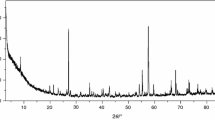Abstract
Two new zinc(II)-2-chlorophenylacetate complexes, {[Zn(2-Cl-C6H4CH2COO)2(Phen)](2-Cl-C6H4CH2COOH)2, 1 and [Zn(2-Cl-C6H4CH2COO)2(bipy)](2-Cl-C6H4CH2COOH)2, 2} with nitrogen donor ligands, 1,10-phenanthroline (phen) and 2,2′-bipyridine (bipy), were synthesized and characterized by IR spectroscopy and single crystal diffraction. Distorted octahedral geometry was confirmed in both complexes. The compounds were studied for the thermal stabilities using TG and DTA methods at different heating rates (283, 288 and 293 K min−1). It was found that both the complexes show the same trend in stabilities and thermally degrade in two stages. The apparent activation energies for each step of specific conversions were determined using the Doyle–Ozawa calculation method according to ICTAC recommendations. The calculated average activation energies for 1 were found to be 17.52/10.19 J mol−1 for the first and second stages of degradation, respectively. Similarly, for 2 corresponding values for the two-stage degradation were found to be 12.45 and 3.485 J mol−1. Determining the enthalpy value of the activation revealed an exergonic nature of the thermal degradation.









Similar content being viewed by others
References
Vallee BL, Falchuk KH. The biochemical basis of zinc physiology. Physiol Rev. 1993;73:79–118.
Berg JM, Shi Y. Science. 1996;271:1081.
Allendorf MD, Bauer CA, Bhakta RK, Houk RJT. Luminescent metal–organic frameworks. Chem Soc Rev. 2009;38:1330–52.
Lee MH, Quang DT, Jung HS, Yoon J, Lee C-H, Kim JS. Ion-induced FRET on–off in fluorescent Calix[4]arene. J Org Chem. 2007;72:4242–5.
Hirano T, Kikuchi K, Urano Y, Higuchi T, Nagano T. Novel zinc fluorescent probes excitable with visible light for biological applications. Angew Chem Int Ed. 2000;39(6):1052–4.
Komatsu K, Urano Y, Kojima H, Nagano T. Development of an iminocoumarin-based zinc sensor suitable for ratiometric fluorescence imaging of neuronal zinc. J Am Chem Soc. 2007;129:13447–54.
Camur M, Bulut M, Kandaz M, Guney O. Synthesis, characterization and fluorescence behavior of new fluorescent probe phthalocyanines bearing coumarin substituents. Polyhedron. 2009;28:233–8.
Li H, Gao S, Xi Z. A colorimetric and “turn-on” fluorescent chemosensor for Zn(II) based on coumarin Shiff-base derivative. Inorg Chem Commun. 2009;12:300–3.
Ikram M, Rehman S, Khan A, Baker RJ, Hofer TS, Subhan F, Qayum M, Schulzke C. Synthesis, characterization, antioxidant and selective xanthine oxidase inhibitory studies of transition metal complexes of novel amino acid bearing Schiff base ligand. Inorg Chim Acta. 2015;428:117–26.
Medintz IL, Mattoussi H, Clapp AR. Potential clinical applications of quantum dots. Int J Nanomed. 2008;3:151–67.
Choulier L, Enander K. Environmentally sensitive fluorescent sensors based on synthetic peptides. Sensors. 2010;10:3126–44.
Tainaka K, Sakaguchi R, Hayashi H, Nakano S, Liew FF, Morii T. Design strategies of fluorescent biosensors based on biological macromolecular receptors. Sensors. 2010;10:1355–76.
Morris MC. Fluorescent biosensors of intracellular targets from genetically encoded reporters to modular polypeptide probes. Cell Biochem Biophys. 2010;56:19–37.
Ojida A, Mito-oka Y, Sada K, Hamachi I. Molecular recognition and fluorescence sensing of monophosphorylated peptides in aqueous solution by bis(zinc(II)–dipicolylamine)-based artificial receptors. J Am Chem Soc. 2004;126:2454–63.
Ojida A, Inoue MA, Mito-Oka Y, Hamachi I. Cross-linking strategy for molecular recognition and fluorescent sensing of a multi-phosphorylated peptide in aqueous solution. J Am Chem Soc. 2003;125:10184–5.
Li JV, Johnston SW, Yan Y, Levi DH. A high-efficiency spin-resolved photoemission spectrometer combining time-of-flight spectroscopy with exchange-scattering polarimetry. Rev Sci Instrum. 2010;81:033910–5.
Sheldrick GM. A short history of SHELX. Acta Crystallogr Sect A. 2008;64:112–22.
Ozawa T. A new method of analyzing thermogravimetric data. Bull Chem Soc Jpn. 1965;38(11):1881–6.
Deacon GB, Philips RJ. Relationships between the carbon-oxygen stretching frequencies of carboxylato complexes and the type of carboxylate coordination. Coord Chem Rev. 1980;33:227–50.
Yang CT, Vetricheran M, Yang X, Moubaraki B, Murry KS, Vittal JJ. Syntheses, structural properties and catecholase activity of copper(II) complexes with reduced Schiff base N-(2-hydroxybenzyl)-amino acids. J Chem Soc Dalton Trans. 2004;113.
Gup R, Gökçe C, Dilek N. Synthesis, structural characterization and DNA interaction of zinc complex from 2,6-diacetylpyridine dihydrazone and 4-[(2E)-2-(hydroxyimino)acetyl]phenoxy acetic acid. J Photochem & Photobio B Biol. 2015;144:42–50.
Carballo R, Castineiras A, Balboa S, Covelo B, Niclos J. Solid state coordination chemistry of copper(II)/α-hydroxycarboxylato/2,2′-bipyridine systems. Polyhedron. 2002;21:2811–8.
Galani A, Efthimiadou EK, Theodosiou T, Kordas G, Karaliota A. Novel levofloxacin zinc (II) complexes with N-donor heterocyclic ligands, as potential fluorescent probes for cell imaging: synthesis, structural characterization and in vitro cytotoxicity. Inorg Chim Acta. 2014;423:52–9.
Qi XX, Ren N, Xu SL, Zhang JJ, Zong GC, Gao J, Geng LN, Wang SP, Shi SK. Lanthanide complexes with 3,4,5-triethoxybenzoic acid and 1,10-phenanthroline: synthesis, crystal structures, thermal decomposition mechanism and phase transformation kinetics. RSC Adv. 2015;5:9261–71.
Zong GC, Huo JX, Ren N, Zhang JJ, Qi XX, Gao J, Geng LN, Wang SP, Shi SK. Preparation, characterization and properties of four new trivalent lanthanide complexes constructed using 2-bromine-5-methoxybenzoicacid and 1,10-phenanthroline. Dalton Trans. 2015;44:14877–86.
Mohamed SK, Knight KS, Akkurt M, Hussein BRM, Albayati MR. Crystal structure of N-[4-amino-5-cyano-6-(methylsulfanyl)pyridin-2-yl]-2-chloroacetamide. Acta Cryst. 2015;E71:o169–70.
Deya D, Roya S, Dutta Purkayastha RN, Pallepogub R, McArdlec P. Zinc carboxylates containing diimine: synthesis, characterization, crystal structure, and luminescence. J Mol Struct. 2013;1053:127–33.
Ikram M, Rehman S, Baker RJ, Rehman HU, Khan A, Choudhary MI, Rehman S-U. Synthesis, and distinct urease enzyme inhibitory activities of metal complexes of Schiff-base ligands: kinetic and thermodynamic parameters evaluation from TG DTA analysis. Thermochim Acta. 2013;555:72–80.
Ikram M, Rehman S, Schulzke C, Baker RJ, Blake AJ, Malook K, Wong H, Rehman S-U. Urease and α-chymotrypsin inhibitory activities of transition metal complexes of new Schiff base ligand: kinetic and thermodynamic studies of the synthesized complexes using TG DTA pyrolysis. Thermochim Acta. 2013;562C:22–8.
Author information
Authors and Affiliations
Corresponding authors
Ethics declarations
Conflict of interest
The authors declare no conflict of interest.
Additional information
The original version of this article was revised. The fourth and fifth author names were combined and published as Mohammad Ibrahim Viola. The correct author group is updated in the article.
An erratum to this article is available at http://dx.doi.org/10.1007/s10973-016-5916-6.
Rights and permissions
About this article
Cite this article
Muhammad, N., Ikram, M., Rehman, S. et al. Structural, thermal kinetics and thermodynamics study of new mixed ligand zinc complexes. J Therm Anal Calorim 128, 627–637 (2017). https://doi.org/10.1007/s10973-016-5842-7
Received:
Accepted:
Published:
Issue Date:
DOI: https://doi.org/10.1007/s10973-016-5842-7




